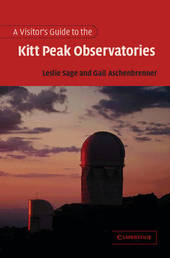
|
A Visitor's Guide to the Kitt Peak Observatories
Paperback / softback
Main Details
| Title |
A Visitor's Guide to the Kitt Peak Observatories
|
| Authors and Contributors |
By (author) Leslie Sage
|
|
By (author) Gail Aschenbrenner
|
| Physical Properties |
| Format:Paperback / softback | | Pages:118 | | Dimensions(mm): Height 186,Width 124 |
|
| Category/Genre | Observatories, equipment and methods |
|---|
| ISBN/Barcode |
9780521006521
|
| Classifications | Dewey:522.1973 |
|---|
| Audience | |
|---|
| Illustrations |
43 Plates, color; 2 Line drawings, unspecified; 43 Line drawings, color
|
|
Publishing Details |
| Publisher |
Cambridge University Press
|
| Imprint |
Cambridge University Press
|
| Publication Date |
22 April 2004 |
| Publication Country |
United Kingdom
|
Description
The Kitt Peak National Observatory is located in the Quinlan Mountains, southwest of Tucson, Arizona. For more than 40 years, astronomers have used the telescopes here to make many remarkable discoveries about the Universe. Today, Kitt Peak is the most visited astronomical observatory site in the world. With over twenty telescopes of different types and sizes, the site gives visitors an indication of the great diversity of modern astronomy. This guide gives a comprehensive tour of the Kitt Peak telescopes, and introduces some of the important science that is done with them. It also points out some of the beautiful surrounding scenery, and gives an idea of what it is like to be an astronomer on the mountain. The book will enable visitors to make the most of their trip, and contains color-coded walking tours of the telescopes.
Author Biography
Leslie Sage is a Senior Editor of Nature, and a Research Associate in the Department of Astronomy, University of Maryland. Gail Aschenbrenner is a Public Affairs Officer in the United States Department of Agriculture Forest Service, Tucson, Arizona.
Reviews'... it is a fascinating insight into what must be a delightful experience. ... For those planning such a trip this book is essential packing, for the rest of us well it's the next best thing!' Astronomy and Space
|